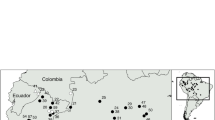Abstract
During a 14-month study of one group of woolly spider monkeys, or muriquis (Brachyteles arachnoides),at Fazenda Montes Claros, M. G., Brazil, the group used a home range of 168 ha. Day-range lengths averaged 1283 m and were longer in the wet season than in the dry season. An analysis of travel rates indicated that the group traveled faster on those days when they traveled farther. The availability of large patches of preferred food sources appears to affect daily movement patterns. Intraspecific comparisons, in addition to an apparent expansion of the study group’s home range as their group size has increased, suggest the importance of group size to muriqui range size. Interspecific comparisons between muriquis and sympatric brown howler monkeys suggest that locomotor adaptations are important to understanding species differences in ranging behavior.
Similar content being viewed by others
References
Aguirre, A. C. (1971).O Mono Brachyteles arachnoides (E. Geoffroy), Academia Brasileira de Ciencias, Rio de Janeiro.
Altmann, J. (1974). Observational study of behavior: Sampling methods.Behaviour 49(3-4): 227–267.
Altmann, S. (1974). Baboons, space, time, and energy.Am. Zool. 14: 221–248.
Cant, J. G. H. (1986). Locomotion and feeding postures of spider and howling monkeys: Field study and evolutionary interpretation.Folia primatol. 46: 1–14.
Chivers, D. J., Andrews, P., Preuschoft, H., Bilsborough, A., and Wood, B. A. (1984). Food acquisition and processing in primates: Concluding discussion. In Chivers, D. J., Wood, B. A., and Bilsborough, A. (eds.),Food Acquisition and Processing in Primates, Plenum Press, New York.
Clutton-Brock, T. H. (1975). Ranging behaviour of red colobus (Colobus badius tephrosceles) in the Gombe National Park.Anim. Behav. 23: 706–722.
Clutton-Brock, T. H., and Harvey, P. H. (1977). Species differences in feeding and ranging behaviour in primates. In Clutton-Brock, T. H. (ed.),Primate Ecology, Academic Press, New York.
Clutton-Brock, T. H., and Harvey, P. H. (1978). Mammals, resources, and reproductive strategies.Nature (London) 273: 191–195.
Fleagle, J. G. (1984). Primate locomotion and diet. In Chivers, D. J., Wood, B. A., and Bilsborough, A. (eds.),Food Acquisition and Processing in Primates, Plenum Press, New York.
Gaulin, S. J. C. (1979). A Jarman/Bell model of primate feeding niches.Hum. Ecol. 7: 1–20.
Hatton, J. C., Smart, N. O. E., and Thomson, K. (1983).An Ecological Study of the Fazenda Montes Claros Forest, Minas Gerais, Brazil, interim report, Department of Botany and Microbiology, University College, London.
Hill, W. C. O. (1962).Primates: Comparative Anatomy and Taxonomy. V: Cebidae, Part B, Interscience, New York.
Kay, R. F. (1984). On the use of anatomical features to infer foraging behavior in extinct primates. In Rodman, P. S., and Cant, J. G. H. (eds.),Adaptations for Foraging in Nonhuman Primates, Columbia University Press, New York.
Leighton, M., and Leighton, D. R. (1982). The relationships of size of feeding aggregate to size of food patch. Howler monkeys (Alouatta palliata) feeding inTrichilia cipo fruit trees on Barro Colorado Island.Biotropica 14(2): 81–90.
McFarland, M. J. (1986). Ecological determinants of fission-fusion sociality inAteles and Pan. In Else, J. G., and Lee, P. C. (eds.),Primate Ecology and Conservation, Cambridge University Press, New York.
Mendes, S. L. (1985).Uso do Espaco, Padroes de Atividades Diaries e Organizicao Social de Alouatta fuscaem Caratinga, M.G., Masters dissertation, Universidade de Brasilia, Brasilia.
Milton, K. (1984). Habitat, diet, and activity patterns of free-ranging woolly spider monkeys (Brachyteles arachnoides E. Geoffroy 1806).Int. J. Primatol. 5: 491–514.
Milton, K., and May, M. L. (1976). Body weight, diet and home range area in primates.Nature (London) 259: 459–462.
Parsons, P.E., and Taylor, C. R. (1977). Energetics of brachiation versus walking: A comparison of a suspended and an inverted pendulum mechanism.Physiol. Zool. 50: 182–188.
Rasmussen, D. R. (1980). Clumping and consistency in primates’ patterns of range use: Definitions, sampling, assessment, and applications.Folia primatol. 34: 111–139.
Rodman, P. S. (1984). Foraging and social systems of orangutans and chimpanzees. In Rodman, P. S., and Cant, J. G. H. (eds),Adaptations for Foraging in Nonhuman Primates, Columbia University Press, New York.
Strier, K. B. (1986).The Behavior and Ecology of the Woolly Spider Monkey, or Muriqui (Brachyteles arachnoidesE. Geoffroy 1806), Doctoral dissertation, Harvard University, Cambridge, Mass.
Strier, K. B. (1987a). Activity budgets of woolly spider monkeys, or muriquis (Brachyteles arachnoides).Am. J. Primatol. 13: 385–395.
Strier, K. B. (1987b). Demographic patterns in one group of free-ranging woolly spider monkeys.Primate Conserv. 8: 73–74.
Strier, K. B. (1987c). Influence of patch size availability on grouping patterns in the woolly spider monkey (Unpublished manuscript).
Waser, P., and Floody, O. (1974). Ranging patterns of the mangabey,Cercopithecus albigena, in the Kibale Forest, Uganda.Z. Tierpsychol. 35: 85–101.
Wrangham, R. W. (1980). An ecological model of female-bonded primate groups.Behaviour 75: 262–299.
Zingeser, M. R. (1973). Dentition of Brachyteles arachnoides with reference to alouattine and ateline affinities.Folia primatol. 20: 351–390.
Author information
Authors and Affiliations
Rights and permissions
About this article
Cite this article
Strier, K.B. Ranging behavior of woolly spider monkeys, or muriquis,Brachyteles arachnoides . Int J Primatol 8, 575–591 (1987). https://doi.org/10.1007/BF02735778
Received:
Revised:
Issue Date:
DOI: https://doi.org/10.1007/BF02735778




